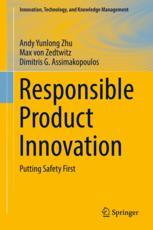

Most ebook files are in PDF format, so you can easily read them using various software such as Foxit Reader or directly on the Google Chrome browser.
Some ebook files are released by publishers in other formats such as .awz, .mobi, .epub, .fb2, etc. You may need to install specific software to read these formats on mobile/PC, such as Calibre.
Please read the tutorial at this link: https://ebookbell.com/faq
We offer FREE conversion to the popular formats you request; however, this may take some time. Therefore, right after payment, please email us, and we will try to provide the service as quickly as possible.
For some exceptional file formats or broken links (if any), please refrain from opening any disputes. Instead, email us first, and we will try to assist within a maximum of 6 hours.
EbookBell Team

4.0
86 reviewsThis book analyses the relationships among product safety strategy and culture, concurrent engineering, new product development (NPD) processes and product safety performance. Product safety is a matter of enormous economic and societal concern, given the safety risks to consumers and the financial risks to producers. Nevertheless, a thorough conceptual understanding of the effects of NPD policies and practices is still largely missing, as several large-scale trends have made clarifying the role of product safety in its socio-economic context difficult, including: the rise of consumerism and the shift in the balance of power from manufacturers to customers and regulators; the internationalization of value chains and the fragmentation of markets worldwide; and technological change leading to a sophistication of products that rendered average consumers increasingly unaware of risk and potential accidents.
This volume sets out to close the gaps among research, practice and policy, with an emphasis on advocating responsible product innovation. Through an in-depth study of the durable juvenile products industry, the authors discover important relationships, for example that top management involvement, safety-first culture and robust NPD processes are paramount in increasing product safety and decreasing product recalls in firms. On the other end of the spectrum, concurrent engineering does not automatically lead to product safety, they found no “magic bullet” through which product safety can be tied to the use of a particular tool, skill, or practice. Offering a dynamic framework for aligning the interests of multiple stakeholders, including manufacturers, regulators, and consumers, the authors provide a clearer understanding of product safety and its implications for scholars, students, policy makers, and practitioners in the areas of innovation management, product management, R&D management, and responsible research and innovation.